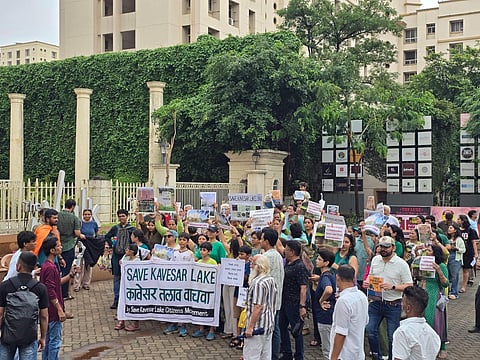
Thane- While much of the world marked World Environment Day on June 5, 2025, with symbolic gestures and lofty declarations, over 100 residents of Thane chose the weight of action over the winds of words. Dressed in black and holding placards, they gathered at the entrance of Kavesar Lake in Hiranandani Estate to protest a proposed “beautification” project. The plan includes the construction of walkways, gazebos, amphitheatres, a “divine courtyard,” toilets, and seating plazas. Far from beautifying the lake, residents argue, the project threatens to erase one of the city’s last remaining natural wetlands and destabilize its delicate ecosystem. In particular, it endangers the rare white lotus that blooms in its waters and the fragile biodiversity the lake supports.
Spanning 2.46 hectares, Kavesar Lake serves as a sanctuary for over 150 species, including local and migratory birds. Once celebrated as the “City of Lakes,” Thane is now struggling to preserve its vanishing water bodies. In a candid statement to The Free Press Journal, then-TMC Commissioner Abhijit Bangar revealed that out of the 70-plus lakes that once dotted Thane, only 34 survive today—many lost to unchecked encroachments and unregulated construction.
Kailash Anerao, a resident of Hiranandani Estate, launched a petition on Change.org urging Thane Municipal Corporation (TMC) and other authorities to halt the destruction of the lake’s riparian and buffer zones and declare it a “wetland” to ensure long-term protection. Garnering over 7,500 signatures, the petition reflects growing public demand to preserve the lake in its natural form. Anerao remarked, “It is human hubris and greed which drives such development projects. Nature does not require humans to beautify it; it merely requests our non-interference and inclusion of the needs of other species trying to survive alongside us.”
On June 9, 2025, members of the Save Kavesar Lake Citizens’ Movement met with TMC Commissioner Saurabh Rao and local MLA Sanjay Kelkar, who represents the constituency. They demanded the immediate cancellation of the beautification project, warning that it would permanently disqualify the lake from being recognised as a wetland under the Wetland (Conservation and Management) Rules, 2017, as recreational infrastructure like walkways and amphitheatres nullifies legal protection. Despite Thane’s reputation as the “City of Lakes,” not a single lake in the city has been officially notified as a wetland. Kavesar is now the last natural one left—others have already been concretised or destroyed.
Kavesar Lake is a thriving ecological habitat that supports a wide variety of wildlife, including wetland birds, nocturnal and terrestrial birds, reptiles, odonates (dragonflies and damselflies), amphibians, fish, turtles, crabs, mammals, and aquatic flora. The lake is home to native plant species such as the rare white lotus, water lilies, reeds, and wetland grasses that keep the water clean and algae-free. The riparian zones—banks and surrounding areas—serve as nurseries for fish and amphibians, nesting grounds for birds and insects, and natural buffers against floods, pollution, and water scarcity.
A preliminary study by experts on the citizens’ panel, which included leading zoologists and environmentalists, identified the following key ecological functions of the lake
Its porous soil facilitates groundwater recharge.
It acts as a natural sponge, mitigating urban flooding during peak monsoons.
Mature trees and marshland absorb carbon and filter pollutants, improving water quality.
Dense vegetation helps regulate local temperatures and purifies air.
It supports a rich web of biodiversity essential to ecological balance.
The Ministry of Jal Shakti considers the conservation and rejuvenation of urban wetlands a national priority. As a signatory to the Ramsar Convention, India is committed to the wise use and protection of its wetlands. In 2008, the Ramsar COP10 adopted Resolution X.27 on “Wetlands and Urbanisation,” expressing concern over the degradation of wetlands in urban and peri-urban areas. It emphasized the responsibility of local governments to protect and sustainably manage wetlands under their jurisdiction.
Despite these commitments, Development agendas backed by TMC undermine environmental safeguards in pursuit of commercialization. These decisions run counter to both national and international obligations and fail to account for the long-term costs of environmental neglect.
In the era of climate crisis, wetlands like Kavesar are not luxuries—they are survival infrastructure. They reduce urban heat islands, buffer against extreme weather, and sustain vital resources. Once concretised, the lake’s ability to recharge groundwater will vanish, worsening water scarcity in surrounding areas. Its role in flood mitigation will be lost, making nearby roads and neighbourhoods more vulnerable to waterlogging and storm surges. Trees that currently absorb carbon and cool the microclimate will be replaced with cement and decorative lighting that contribute nothing to climate resilience.
If municipalities continue to prioritise short-term construction and commercialization over long-term ecological security, cities like Thane will soon be forced to spend billions on artificial solutions—flood control walls, sea barriers, air purification towers, water recharge infrastructure—which functioning wetlands naturally and freely provide.
The struggle to save Kavesar Lake is not just about one wetland—it is about what kind of cities we wish to build and live in. Will our urban future be driven by aesthetics and private profits, or by sustainability and shared survival? In the name of “beautification,” we are witnessing the slow burial of a living ecosystem that cools our air, absorbs our floodwaters, nurtures biodiversity, and connects us to nature. The choice before us is clear: either we act now to protect what remains, or we pave over our future in concrete, only to rebuild in desperation what nature gave us freely.
- The author is a graduate in political science and been involved in people’s movement in Mumbai and Thane specifically FSC Mumbra and Collective Mumbai,a student and youth organization.
You can also join our WhatsApp group to get premium and selected news of The Mooknayak on WhatsApp. Click here to join the WhatsApp group.